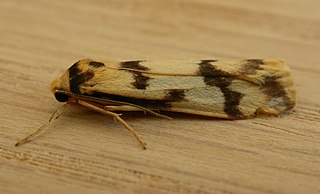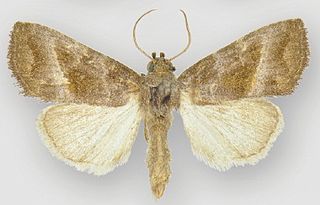Related Research Articles

Clitocybe nuda, commonly known as the wood blewit and alternately described as Lepista nuda, is an edible mushroom native to Europe and North America. Described by Pierre Bulliard in 1790, it was also known as Tricholoma nudum for many years. It is found in both coniferous and deciduous woodlands. It is a fairly distinctive mushroom that is widely eaten, though there is some caution about edibility. Nevertheless, it has been cultivated in Britain, the Netherlands and France.
The Field Elm cultivar Ulmus minor 'Viminalis Marginata', a variegated form of Ulmus minor 'Viminalis', was first listed as Ulmus campestris var. viminalis marginataHort. by Kirchner in 1864. Both Van Houtte and Späth marketed an U. campestris viminalis marginata in the late 19th century.

Halone is a genus of moths in the subfamily Arctiinae from southern Asia and Australia. The genus was erected by Francis Walker in 1854.
Lepista is a genus of moths in the subfamily Arctiinae. The genus was described by Wallengren in 1863.

Tigrioides is a genus of moths in the family Erebidae. The genus was erected by Arthur Gardiner Butler in 1877.

Ogdoconta is a genus of moths of the family Noctuidae.

Lichenaula is a genus of Australian moth of the family Xyloryctidae.
Aeolochroma turneri is a moth of the family Geometridae first described by Thomas Pennington Lucas in 1890. It is found in Australia's Northern Territory and Queensland.
Aeolochroma viridicata is a moth of the family Geometridae first described by Thomas Pennington Lucas in 1890. It is found in Australian states of New South Wales and Queensland. Adultsts have a complex green and brown or grey pattern.
Eressa angustipenna, the black-headed wasp moth, is a moth of the family Erebidae. It was described by Thomas Pennington Lucas in 1890. It is found in Australia, as well as the Philippines.
Halone interspersa is a moth of the subfamily Arctiinae. It was described by Thomas Pennington Lucas in 1890. It is found in Australia.
Goniosema anguliscripta is a moth of the subfamily Arctiinae. It was described by Thomas Pennington Lucas in 1890. It is found in Australia, where it has been recorded from New South Wales and Queensland.
Lepista pandula is a moth of the subfamily Arctiinae. It was described by Jean Baptiste Boisduval in 1847. It is found in Kenya, Malawi, Mozambique, Somalia, South Africa, Tanzania and Uganda.
Giaura punctata is a moth in the family Nolidae. It was described by Thomas Pennington Lucas in 1890. It is found on the Bismarck Islands and on New Guinea and Australia.
Scaptesyle equidistans is a moth in the subfamily Arctiinae. It was described by Thomas Pennington Lucas in 1890. It is found in Australia, where it has been recorded from Queensland and New South Wales.
Stenoscaptia venusta is a moth in the family Erebidae first described by Thomas Pennington Lucas in 1890. It is found in Australia, where it has been recorded from the Australian Capital Territory, New South Wales and Queensland.
Pseudanarta pulverulenta is a species of cutworm or dart moth in the family Noctuidae. It is found in North America.
Melanchra pulverulenta is a species of cutworm or dart moth in the family Noctuidae. It is found in North America.
References
- ↑ Savela, Markku. "Lepista pulverulenta (Lucas, 1890)". Lepidoptera and Some Other Life Forms. Retrieved October 11, 2019.
- ↑ Australian Faunal Directory
- Pitkin, Brian & Jenkins, Paul. "Search results Family: Arctiidae". Butterflies and Moths of the World. Natural History Museum, London.
| This Lithosiina-related article is a stub. You can help Wikipedia by expanding it. |